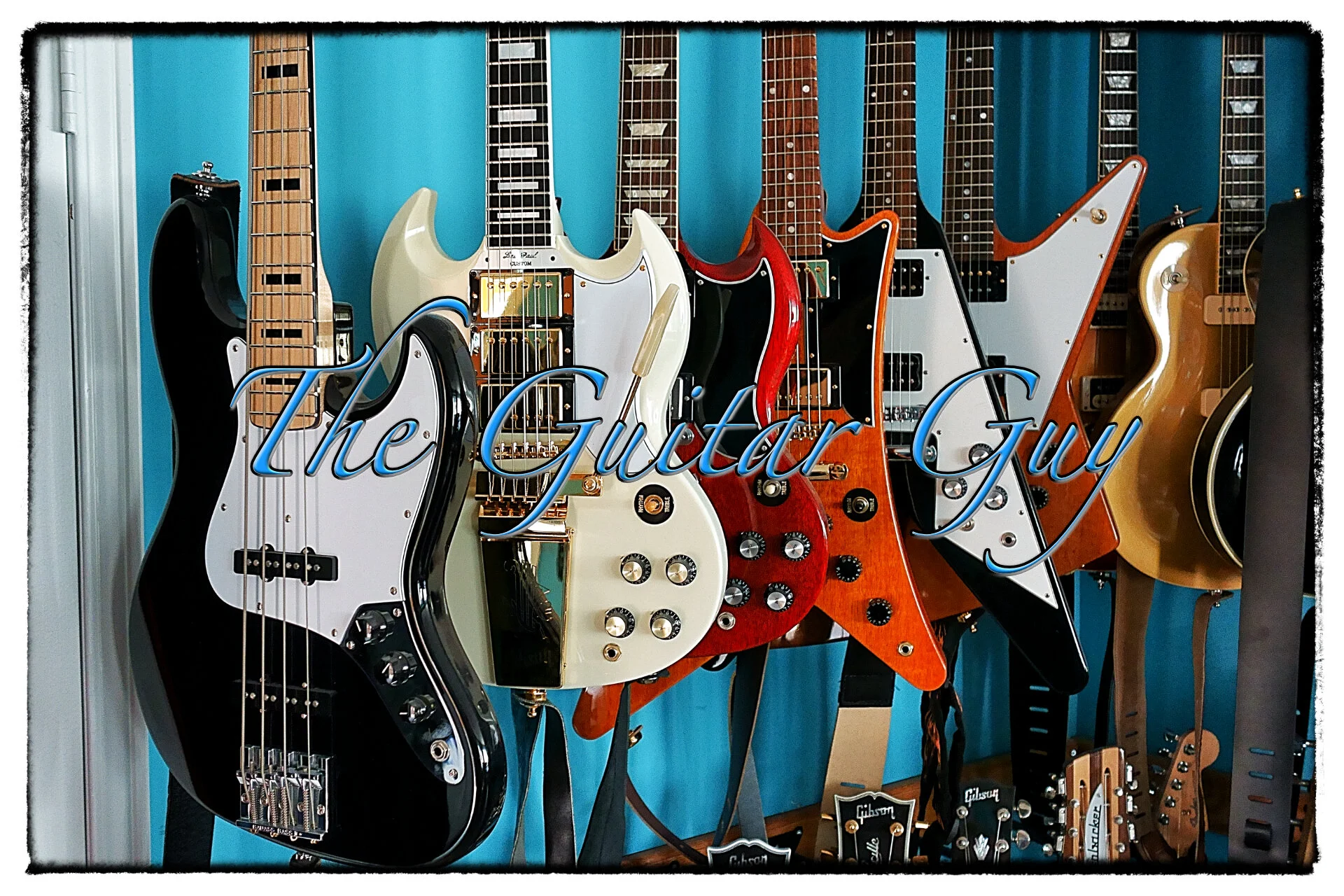
Stress Relief
Maybe you never get stressed out. Maybe every day is just perfect and nothing annoys or upsets you. That would be cool, but it's not me. And that's one way that playing guitar helps enormously.
Sometimes it's just the sound and mood that gets created that contributes. While big bodied jazz boxes are certainly not all the rage these days, there is a magic therein.
My ES-175D is from the early 90's. It took me a while to get in a groove with it. It's after all a "jazz" guitar and except for some chords and a short solo from Take 5, my jazz skills are near invisible. I've recently been spending more time with it since adding the Fender 65 Blackface Twin Reverb to my playing area.
The ES-175D is commonly referred to as an archtop. Gibson has done all manner of archtop guitars over the years. Mine is equipped with the stock humbuckers that came with the guitar in the early nineties. I love the sharp point on the florentine cutaway, and the big deep body has a lot of natural resonance. Held to the ear, its tone is warm and liquid.
I have the ES-175 strung with D'Addario Chromes. My setup is the 11-50 gauge set. Chromes, if you have never played them, are flat wounds and fall into the mellow category of strings.
My preferred mellow strings, the D'Addario Chromes
For some time I was not excited about the tone that I was getting from the guitar into my existing amps. It wasn't bad, certainly a better player could get better tone, but when I got the Twin Reverb, things changed for me and the guitar. Instead of fighting with the amp and guitar controls, I could just sit and play. There was the big airbox warmth and mellow ness, without losing all the spark of the bridge humbucker or the high strings with the neck humbucker. If ever an amp and a guitar went together, this pair seemed to be it.
THE amp to use with the ES-175
As regular readers will have noticed, I am a serious pedal geek and I wanted to see what I could do with minimal pedals. I limited myself to only two pedals for this exercise and am very happy with the results. Of course, I am using the fabulous reverb built into the amp, so that should probably count as one, but I don't count it. The only pedals are a TC Electronics Polytune 3 in stroboscopic mode and my fave Cali76 compressor.
My go to compressor on the Fender Twin
I have too many compressors. Diamonds, an Empress and a pair from Origin Systems, the Cali76 and the Stacked. I also like the basic compressor from Robert Keeley, but in all my testing, nothing pairs with the Fender Twin like the Cali76. It's just so good. It's compression without squishiness while delivering sustain for days, particularly in conjunction with a hollow body guitar.
Putting all the pieces together, I get this warm, voluptuous tone that encourages the development of interesting chord progressions and new riffs. I lack the skill to write music out, and my sight reading skills are quite poor. So I sit with a little Zoom recorder and when I come across something that I like the sound of, I hit record, play the bit a few times and then add some voice reminders of key, what chords, I am playing, the starting notes and any patterns involved. This helps me a lot with getting the approach down, because while I know what I like, I suck at writing out a rhthym so recording it makes sense for me, and might for you as well.
By keeping things simple in the sonic change, the work falls back to me and my fingers to get the job done properly. In my recent stress relief sessions that has worked out well, and I have been able to create some stuff that I find interesting and may end up going somewhere. After an hour or so, I realize that I have not been conscious of the passage of time, that my blood pressure and heart rate has relaxed. What stress was troubling me has subsided and I am in a better state.
It's written that music can calm the savage beast. Not so sure how beastly or savage I am, but the tone from this combination is absolutely a winning ticket.
Review : Origin Effects Cali76 Compressor
Readers may start wondering if the only pedal that I really care about is the compressor considering how much web time I give them. Fair comment, but it is my opinion that the compressor is an under utilized tool that any guitarist or bassist can benefit from when used effectively.
The Cali76 from Origin Effects draws its name from the well respected UREI 1176 from Universal Audio that came out in the late nineteen sixties. The 1176 was a solid state design based on a Field Effect Transistor infrastructure (FET). The 1176 has been used on thousands of recordings because of its low noise, wonderful sound, fast attack and massive gain. My article on compressors in general explains terminology and common functions.
The Cali76 is a stomp box styled compressor. Instead of a VU meter, there is an LED in jewel fixture that changes colour depending on what is happening with the signal. Red is no compression, orange is compression being done, and yellow indicates compression of high input levels and the use of limiting. The original 1176 was marketed as a Limiter before it was talked about as a compressor.
The version that I bought, from Electricmojoguitars.com in Quebec is the Compact Deluxe or CD model. In addition to the meter lamp, there is a silent no click footswitch, mono in and outs, a power in port that will work from 9v to 18v and six control knobs.
It also comes with effective documentation, which you should read since the rotation direction of the knobs may be opposite to your assumption. There are both input and output level controls, so you can maximize the use with your guitar and if you wish also use the Cali76 as a clean boost. Clean boost does not mean that your amp may not be overdriven, it simply means that the boost has no coloration. This is something definitely not clear on the web or in some guitar stores. There is also a Dry control so you can mix your dry signal with the compressed signal. There is no “right answer” but Origin Effects’ documentation does provide some suggestions based on what you wish to achieve.
The ratio knob, controls, surprise, the compression ratio and I noticed that using higher levels of ratio does not immediately mean achieving audio mud. The circuit design in this regard is marvellous and it also doesn’t give that squished into a small can sound. Attack controls how quickly the compressor reacts to the incoming signal. Decay controls how quickly or slowly the compressor releases the signal.
With some judicious tweaking, you can get sustain that lasts for days, without things sounding all squishy or the compressor sounding like it is pumping audio. You can get bad sound if you try, as with any effect, but as with salt, a little goes a long way.
My first serious test involved a SRV Strat into a blackface Twin Reverb. Strats and Twins were made for each other, and I love the sound of a Strat in switch position four into a clean Twin with some reverb happening. Adding in the Cali76 did not usurp that tonal joy as does happen with many compressors, and I felt that harmonics were more open and the sustain was significantly enhanced.
Stevie Ray Vaughan was known for playing through a Tube Screamer into a Twin. I can barely spell SRV let alone achieve his sound, but I just don’t like the Tube Screamer sound with this combo, even when set to the secret and widely published SRV settings. Instead, I put a TC Electronic Spark Booster after the Cali76 and before a Diamond Memory Lane delay. I have been experimenting with Boosts, and in this configuration with gain up and the volume down on the Spark, when I kicked in the Cali76 the soaring sustaining lead tone is stupendous. It’s not distorted or fuzzy. It’s this beautiful warm subtly overdriven sound which is happening at the amp input stage. The only downside that I have found so far is that rolling off the volume control on the guitar does not clean up as it might with a Tube Screamer, but the quality of tone with the Cali76, with or without the Spark is worth it. This is also one of those scenarios so beloved of guitar pundits. In this setup, you can definitely hear a tonal difference between string weights. I keep the SRV strung with .12s, and even comparing to another Strat with Texas Specials pickups and .10s the tone from the heavier strings is much richer and warmer.
NOTE : The board configuration is changing as I just received my Origin Effects Revival Drive Compact. More to come on that.
I found this interesting as in general, I have to be honest, I cannot hear a tonal difference of different weight strings with the same pickups into the same amp. Adding the Cali76 and the Spark, there is a real difference, and I can still hear the difference with no boost at all when the compressor is invoked.
The Cali76 is not what I would call inexpensive. Regular readers will know that I like the Diamond Compressor and am very impressed with the Empress Effects Compressor. For those wishing to spend less, go for the Keeley Compressor Plus which is, in my opinion, the best value out there in its price range. However, if you are willing and able to spend over $400 CAD for a compressor, you want an Origin Effects Cali76. I bought it and kept it.
Will I buy any other compressors? Yes, I am waiting for the Cali76 Stacked Edition to come back into stock as I have a feeling that running an awesome compressor into another one of itself will be amazing. I’ve done this in the digital recording realm for a while using software based compressors with some really positive success, and now want to see what I can do with one live, perhaps on a really powerful acoustic tone.
Keep on playing
